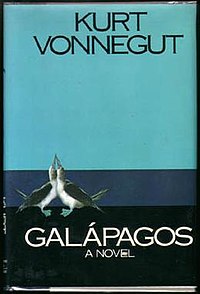Galápagos (novel)

Cover of first edition (hardcover)
|
|
| Author | Kurt Vonnegut |
|---|---|
| Country | United States |
| Language | English |
| Genre | Novel |
| Publisher | Delacorte Press |
|
Publication date
|
1985 |
| Media type | Print (hardback & paperback) |
| ISBN | |
| OCLC | 220388927 |
Galápagos is the eleventh novel written by American author Kurt Vonnegut. The novel questions the merit of the human brain from an evolutionary perspective. The title is both a reference to the islands on which part of the story plays out, and a tribute to Charles Darwin on whose theory Vonnegut relies to reach his own conclusions. It was first published in 1985 by Delacorte Press.
Galápagos is the story of a small band of mismatched humans who are shipwrecked on the fictional island of Santa Rosalia in the Galápagos Islands after a global financial crisis cripples the world's economy. Shortly thereafter, a disease renders all humans on Earth infertile, with the exception of the people on Santa Rosalia, making them the last specimens of humankind. Over the next million years, their descendants, the only fertile humans left on the planet, eventually evolve into a furry species resembling sea lions: though possibly still able to walk upright (it is not explicitly mentioned, but it is stated that they occasionally catch land animals), they have a snout with teeth adapted for catching fish, a streamlined skull and flipper-like hands with rudimentary fingers (described as "").
The story's narrator is a spirit who has been watching over humans for the last million years. This particular ghost is the immortal spirit of Leon Trotsky Trout, son of Vonnegut's recurring character Kilgore Trout. Leon is a Vietnam War veteran who is affected by the massacres in Vietnam. He goes AWOL and settles in Sweden, where he works as a shipbuilder and dies during the construction of the ship, the Bahía de Darwin. This ship is used for the "Nature Cruise of the Century". Planned as a celebrity cruise, it was in limbo due to the economic downturn, and due to a chain of unconnected events the ship ended up allowing humans to reach and survive in the Galápagos.
...
Wikipedia
